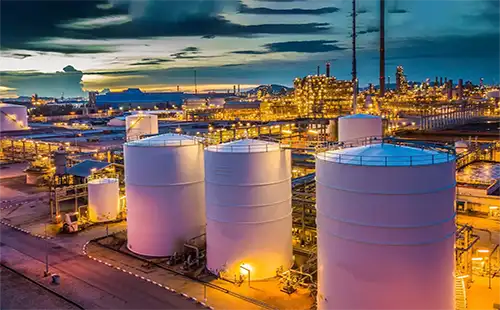The petrochemical industry, a cornerstone of the modern economy, plays a pivotal role in transforming raw hydrocarbons into a vast array of valuable products. At the heart of this industry lies refractory materials, which serve an indispensable function in various refining and production processes.
This article delves into a comprehensive examination of refractory materials in the petrochemical industry, encompassing their types, applications, advantages, and the challenges faced by this sector.
What are Refractory Materials?
Refractory materials are a class of mineral or synthetic substances specifically designed to withstand extremely high temperatures without melting, deforming, or degrading. These materials find extensive applications in various industries, including petrochemical, steel, glass, and ceramics.
Types of Refractory Materials in the Petrochemical Industry
Refractory Bricks
These sturdy bricks, crafted from clay and other refractory minerals like silica, alumina, and magnesia, are employed in the construction of furnace walls, reactors, and chimneys. Their primary function is to provide thermal insulation and safeguard equipment from extreme temperatures and chemical corrosion.
Refractory Concrete
Refractory concrete, a composite of refractory cement, refractory aggregates, and water, serves as a mortar for bonding refractory bricks and filling gaps. Besides its high strength, it exhibits resistance to heat and chemicals, preventing fluid infiltration into furnaces.
Refractory Ceramics
Refractory ceramics, composed of metal oxides such as alumina, zirconia, and silicon carbide, are renowned for their exceptional resistance to heat, corrosion, and thermal shocks. They are utilized in specialized applications like the inner lining of furnaces and reactors.
Refractory Fibers
Refractory fibers, manufactured from materials like ceramics, fiberglass, and carbon, are valued for their lightweight and flexible properties. They are employed in the insulation of pipes, tanks, and other intricate equipment.
Castable Refractories
Castable refractories, a mixture of refractory powders and binders, are poured and solidified into the desired final shape. These materials are used to fill voids and gaps, as well as to fabricate refractory components with complex geometries.
Applications of Refractory Materials in the Petrochemical Industry
Refractory materials are indispensable in various petrochemical processes, including:
- Cracking and Reforming: Refractory bricks and linings are employed in cracking and reforming furnaces to convert heavy hydrocarbons into lighter, more valuable products like ethylene and propylene.
- Steam Reforming: Refractory ceramics and castables are utilized in steam reforming units to produce hydrogen, a crucial feedstock for ammonia synthesis.
- Ethylene Production: Refractory fibers are used to insulate ethylene production furnaces, ensuring efficient heat transfer and minimizing energy consumption.
- Syngas Production: Refractory concrete is employed in syngas production units to withstand the extreme temperatures and corrosive environments involved in the conversion of natural gas or coal into synthesis gas.
Advantages of Refractory Materials in the Petrochemical Industry
The widespread adoption of refractory materials in the petrochemical industry stems from their numerous advantages:
- High-Temperature Resistance: Refractories can withstand extreme temperatures without melting or degrading, ensuring the integrity of furnaces, reactors, and other critical equipment.
- Corrosion Resistance: Refractories exhibit exceptional resistance to chemical attack from various process fluids, extending the lifespan of equipment and reducing maintenance costs.
- Thermal Insulation: Refractories effectively retain heat within furnaces and reactors, optimizing energy efficiency and minimizing heat losses.
- Abrasion Resistance: Refractories can withstand wear and tear from abrasive materials, ensuring the longevity of equipment in harsh environments.
- Dimensional Stability: Refractories maintain their shape and dimensions under extreme conditions, preventing structural failures and ensuring process reliability.
Challenges Facing the Refractory Industry in the Petrochemical Sector
Despite their remarkable advantages, the refractory industry in the petrochemical sector faces several challenges:
- Extreme Operating Conditions: The harsh environments and extreme temperatures encountered in petrochemical processes pose significant challenges for refractory materials.
- Corrosion and Wear: The continuous exposure to corrosive chemicals and abrasive materials necessitates the development of increasingly resistant refractory formulations.
- Thermal Shock Resistance: Rapid temperature fluctuations can lead to thermal cracking and spalling of refractory materials, demanding the development of materials with superior thermal shock resistance.
- Environmental Regulations: Stringent environmental regulations governing emissions and waste disposal necessitate the development of eco-friendly refractory materials.
- Cost-Effectiveness: The high cost of raw materials and manufacturing processes for refractory materials poses a challenge in balancing performance and affordability.
Conclusion
Refractory materials stand as the cornerstone of the petrochemical industry, enabling the efficient and sustainable conversion of raw materials into valuable products that underpin modern society. As the industry continues to evolve, the development of advanced refractory materials with enhanced performance and eco-friendliness will remain a critical area of focus. These innovations will not only optimize petrochemical operations but also contribute to a cleaner and more sustainable future.


Leave a Reply